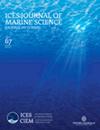在凯尔特海生态区,单一物种配额导致多物种拖网渔船在物种相对丰度波动时丢弃物种
IF 3.4
2区 农林科学
Q1 FISHERIES
引用次数: 0
摘要
我们的研究调查了底层獭拖网渔船在全面实施上岸义务之前 17 年的丢弃模式。对海上采样数据采用了广义加法建模方法,以研究 2002 年至 2018 年凯尔特海生态区鳕鱼、鳕鱼、无须鳕和黑线鳕单位努力量丢弃量(DPUE)的最重要驱动因素。对许多操作、环境、监管和时空因素进行了测试。对最小养护参考尺寸(MCRS)以上和以下的鱼类分别建模,以比较这两类无用渔获物丢弃的驱动因素。在全时段分析中,决定 DPUE 的三个最重要因素是地理位置、地理位置与年份之间的交互作用以及年份与月份之间的交互作用。对时间序列子集的进一步分析表明,配额可用性对 <MCRS 黑线鳕、<MCRS 鳕鱼和 >MCRS 无须鳕的 DPUE 有显著影响,而分配给某一物种的配额往往对其他物种和尺寸等级的 DPUE 有显著影响。配额与丰度的相互作用对所有 >MCRS 鱼种和 <MCRS 无须鳕都有显著影响。这表明,在配额限制下,相对丰度的变化会加剧丢弃。总之,这些结果从经验上证明,单一物种配额是造成混养丢弃的主要原因。本文章由计算机程序翻译,如有差异,请以英文原文为准。
Single-species quotas drive discards by multi-species trawlers in the Celtic Seas ecoregion when their relative abundance fluctuates
Our study investigated discarding patterns by bottom otter trawlers over 17 years prior to the full implementation of the Landing Obligation. A generalized additive modelling approach was applied to at-sea sampling data to examine the most important drivers of the discards per unit effort (DPUE) of cod, whiting, hake, and haddock in the Celtic Seas ecoregion from 2002 to 2018. Many operational, environmental, regulatory, and spatio-temporal factors were tested. Fish above and below the minimum conservation reference size (MCRS) were modelled separately to compare drivers of discarding of these categories of unwanted catch. In the full time period analysis, the three most important factors in determining DPUE were geographic location, an interaction between geographic location and year, and year interacting with month. Further analysis of a subset of the time series indicated that quota availability significantly impacted the DPUE for <MCRS haddock, <MCRS whiting, and >MCRS hake, while the quota allocated for one species often significantly influenced the DPUE of other species and size classes. Quota interacting with abundance had a significant impact for all >MCRS species and <MCRS hake. This indicates that changes in relative abundance compound discarding under quota constraints. Collectively, these results empirically demonstrate that single-species quotas majorly contribute to discards in a mixed-fisheries context.
求助全文
通过发布文献求助,成功后即可免费获取论文全文。
去求助
来源期刊

ICES Journal of Marine Science
农林科学-海洋学
CiteScore
6.60
自引率
12.10%
发文量
207
审稿时长
6-16 weeks
期刊介绍:
The ICES Journal of Marine Science publishes original articles, opinion essays (“Food for Thought”), visions for the future (“Quo Vadimus”), and critical reviews that contribute to our scientific understanding of marine systems and the impact of human activities on them. The Journal also serves as a foundation for scientific advice across the broad spectrum of management and conservation issues related to the marine environment. Oceanography (e.g. productivity-determining processes), marine habitats, living resources, and related topics constitute the key elements of papers considered for publication. This includes economic, social, and public administration studies to the extent that they are directly related to management of the seas and are of general interest to marine scientists. Integrated studies that bridge gaps between traditional disciplines are particularly welcome.
 求助内容:
求助内容: 应助结果提醒方式:
应助结果提醒方式:


